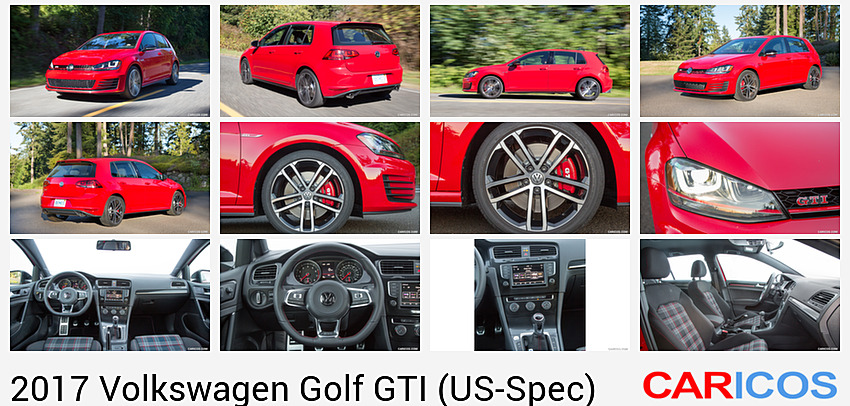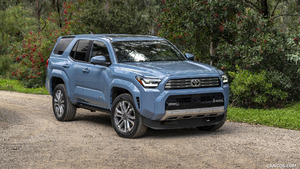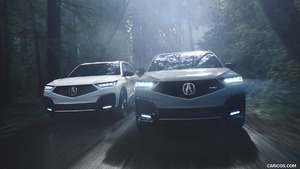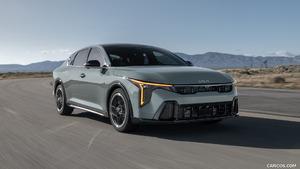2017 Golf GTI (US-Spec)
The car that defined the term “hot hatch” embodies a classic formula: refinement, style, power, and playful performance. It’s a package that has met with great success since the GTI’s U.S. debut in 1983, with the 2015 Golf GTI winning the 2015 North American Car of the Year, along with the Golf. The GTI has received more than a dozen awards since its redesign for the 2015 model year.
New for 2017
After a ground-up redesign for 2015, the Golf GTI continues to add value for model year 2017. The range has simplified options and a new Sport trim for 2017. The GTI Sport is a four-door model with standard Performance Package—brakes from the Golf R; electronically controlled, torque sensing, limited-slip VAQ differential; and a 10-horsepower increase to 220 horsepower (achieved with premium fuel) — as well as 18-inch “Nogaro” aluminum-alloy wheels and Bi-Xenon headlamps with LED Daytime Running Lights. The Sport also features unique floormats, KESSY® keyless access with push-button start and black mirror caps.
The Performance Package is no longer available on the two- and four-door S trim, but is now standard on the SE and Autobahn trims. A Lighting Package that features Bi-Xenon headlights and the Adaptive Front-lighting System (AFS) is standard on the SE. The Driver Assistance Package for the SE models (sold order only) includes: Adaptive Cruise Control (ACC), Forward Collision Warning and Autonomous Emergency Braking (Front Assist), and Blind Spot Monitor with Rear Traffic Alert.
 2017 Volkswagen Golf GTI (US-Spec)
2017 Volkswagen Golf GTI (US-Spec)
Compared with 2016 models, the 2017 Autobahn trim adds standard Adaptive Cruise Control (ACC), Forward Collision Warning and Autonomous Emergency Braking (Front Assist), and Blind Spot Monitor with Rear Traffic Alert and Bi-Xenon headlamps with LED DRLs. An available Driver Assistance Package (sold order only) adds front and rear Park Distance Control (Park Pilot), Parking Steering Assistant (Park Assist), Lane Departure Warning (Lane Assist), and High Beam Control (Light Assist). When activated, this latter feature automatically turns on the high beams above 40 mph, if it detects that there is a low likelihood of dazzling oncoming traffic.
Exterior
The seventh-generation car is wrapped in sheet metal that is modern, yet equally unmistakable as a Volkswagen Golf GTI. The shape and design elements remain as defined as ever, with a distinctive C-pillar, roofline framing, and classic Golf GTI side windows, but the striking new front end and steeply sloped hood leave no doubt this is different from previous generations.
The look is further accentuated by the sharper headlight clusters and the bright-red horizontal strip that runs through the available Bi-Xenon headlights, as well as by the narrower grille, which leads to a strong character line that travels along the side and all the way back to the taillight clusters, only breaking for the wheelarches. Just above, another body line can be traced from the rear side window all the way back up to the headlights. These subtle body lines help create a poised yet elegant appearance.
In addition to the red-colored horizontal highlight on the grille, the 2017 Golf GTI has several other visual differences from its conventional Golf brethren. The lower front fascia incorporates standard LED foglights (not available on Sport trim) housed within a series of horizontal strakes on either side of a unique mesh pattern grille. Red-painted brake calipers peek behind bespoke GTI wheels and subtle side skirts help to give the GTI a more planted appearance. Around back, bright exhaust tips sit on either side of a unique rear diffuser, and a roof spoiler further differentiates the car.
Dimensionally, the Golf GTI grew for 2015 in all directions but up. Overall length increased by 2.1 inches, while width gained 0.5 inches. Overall height decreased, however, by 1.1 inches, making the car look more ready to pounce than ever. Thanks to the MQB architecture, which dictates a fixed relationship between the front-wheel centerline and the pedalbox, the front wheels sit 1.7 inches further forward, giving a premium “cab backward” aesthetic.
Along with the shaping and the horizontal design emphasis, these proportions help the Golf GTI achieve a lower visual center of gravity and a more dynamic stance, helped by a sport suspension that lowers the car by 0.6 inches compared with a regular Golf. The Golf GTI is equipped with large 18-inch wheels as standard equipment, wrapped in standard all-season or optional 225/40 summer performance tires. A panoramic power tilt and slide sunroof is standard equipment on the SE and Autobahn models.
A stand-alone Lighting Package is available on the Golf GTI SE trim for $995, and comes standard with the Sport and Autobahn trim levels: it consists of Bi-Xenon headlights and LED Daytime Running Lights, as well as Volkswagen’s Adaptive Front lighting System. This system swivels the main headlight beams by up to 15 degrees as the steering wheel is turned to help illuminate bends in the road more effectively at speeds of more than 6 mph. Automatic rain-sensing windshield wipers are standard on SE models and above, along with automatic headlights.
Interior
The large, mature cabin has an emphasis on comfort and a substantial features list. There is 93.5 cubic feet of interior room, along with 16.5 cubic feet up of luggage space up to the parcel shelf and 22.8 cu ft to the roof. That’s more luggage room than even the largest midsize sedan. The versatility of the load space is enhanced by a trunk floor that can be raised or lowered, while the 60:40 split backrest can be folded to give an almost flat cargo area that can easily accommodates a full-size bicycle. With the rear seats folded, the Golf GTI has 52.7 cu ft of cargo capacity.
In addition to the spacious interior, the driver controls are positioned to help optimized ergonomics and usability. The seat position, height of the shifter and the spacing between the pedals are fine-tuned for increased driver comfort. This new driver-centric design focus is evident from the center stack, which is angled towards the driver—a trait frequently seen in premium luxury or performance vehicles.
The Golf GTI’s premium performance personality is further accentuated by the red ambient lighting and illuminated door sills; black headliner and trim inserts; buttons and switches that are backlit in white; and the use of premium materials and soft-touch plastics throughout. A GTI specific instrument cluster, sporty aluminum-look pedals, the unique shifter knob, and the flat-bottomed sport steering wheel also ensure differentiation from its less sporty siblings.
An equal amount of attention has been paid to helping maximize comfort and convenience. The standard front sport seats, with classic GTI “Clark” plaid seating surfaces, can be heated, and there are six cup holders. Cruise control switches and media controls are housed on the leather-wrapped multifunction steering wheel.
The Golf GTI S includes a rearview camera, leather-wrapped multifunction steering wheel, ambient and footwell lighting with LED reading lights, LED foglights, and Driving Mode Selection.
The new Golf GTI Sport is a four-door model with manual transmission, 18 inch “Nogaro” wheels, KESSY keyless access with push-button start, Black painted mirror housings, body-colored moldings, door handles, and bumpers. The Sport also comes equipped with the aforementioned Lighting package as standard.
In addition to the standard features of the Golf GTI S, SE models are equipped with KESSY keyless access with push-button start, automatic headlights and rain-sensing wipers, and the highly acclaimed Fender® Premium Audio System, as well as leather seating surfaces and a panoramic power tilt and slide sunroof. The top-of-the-line Autobahn variants add the standard navigation system, Climatronic® automatic climate control, and a 12-way power driver’s seat.
All 2017 Golf GTI models come equipped with a MIB II touchscreen infotainment system. The infotainment system offers one of the most comprehensive suites of connected vehicle services and features available in the automotive industry today. Features available through Volkswagen Car-Net® are divided into three key areas, App-Connect, Security & Service, and Guide & Inform.
App-Connect. The Composition Media unit is standard on the S, Sport, and SE models. It features an 800x480 capacitive color touch display with a 6.5-inch screen and proximity sensor. Standard features include AUX-in, an SD card slot, a USB multimedia interface for compatible Apple iPhone® and iPod® devices; Reverse camera display; Bluetooth® technology with audio streaming and the ability to sync two compatible phones simultaneously and send and receive SMS text messages with compatible phones; App-Connect for compatible smartphone integration, a JPEG viewer, SiriusXM® Satellite Radio with three-month trial, HD Radio and support for lossless audio file format (Free Lossless Audio Codec FLAC).
Autobahn models include as standard the Discover Media unit, which captures the features available in the Composition Media unit and adds 2.5D Navigation, one-shot voice destination entry, predicts possible destinations based on often used routes, and Destination Entry with Quick Search and Auto-complete, and XX month trial of Car-Net Guide & Inform.
Security & Service. With the Car-Net Security & Service suite, owners can access their VW remotely through vw.com/carnet as well as a smartphone app, and an in-car Car-Net button console, providing access to the features available from virtually anywhere your mobile device is connected to wireless internet.
Available security related features include Automatic Crash Notification, which can automatically notify an operator who can contact first responders in the event of an collision; Manual Emergency Call, a feature that allows for quick access to customer specialists at the touch of a button; Roadside Assistance, for added peace-of-mind in the event of trouble on the road; and Stolen Vehicle Location Assistance, which uses VW Car-Net Security & Service to assist law enforcement with locating your vehicle in the event that it is stolen.
In addition, Volkswagen Car-Net Security & Service offers layers of convenience, such as remote vehicle access, remote door lock and unlock, remote honk and flash (of lights), last parked location information, and remote status check (doors and windows).
The Car-Net Security & Service also offers Family Guardian, a suite of features that help families. Features including speed alert, which can notify the owner of the vehicle when the preset maximum speed limit is exceeded; and boundary alert, which can alert you if the vehicle has traveled outside of a pre-set virtual boundary.
Diagnostics and maintenance information is also available through VW Car-Net. A Vehicle Health Report allows Volkswagen customers to check to see an overview of vehicle diagnostics. When it’s time for scheduled service, Car-Net Security & Service can not only alert the customer, but also provide a simple way to schedule a dealer visit. It can even identify the closest dealer in case you need a recommendation.
Guide & Inform. Car-Net Guide & Inform offers an enhanced navigation and infotainment experience for Volkswagen drivers. Volkswagen has incorporated technologies that enhance existing navigation offerings while adding an additional level of information that can empower owners.
Satellite navigation is refined with Car-Net Guide & Inform, incorporating several layers of information right onto the infotainment screen. Every CC features fuel prices, sports scores, movie information and weather data as part of the three-month SiriusXM Travel Link trial. Volkswagen customers will also enjoy traffic information and a complimentary four-year SiriusXM Traffic trial.
Customers purchasing new Volkswagen models equipped with Volkswagen Car-Net Security & Service connected vehicle services (not including App-Connect) will receive a no-charge trial for six months after purchase. To extend the benefits of this connectivity system, customers can choose from a number of Volkswagen Car-Net payment options: 1 year, for $199; 2 years for $378; 3 years for $540; or, month-to-month, for $17.99.
Powertrain
In classic Volkswagen style, the Golf GTI is powered by a compact turbocharged engine. The 2.0-liter TSI® turbocharged and direct-injection unit that powers the Golf GTI is a member of the latest, third-generation EA888 engine family and is built in Volkswagen’s state-of-the-art factory in Silao, Mexico. The EA888 engine line is a masterpiece of modern engine design that provides high levels of performance, efficiency, and drivability in a lightweight, compact package.
The EA888 engine produces 210 horsepower (achieved on premium fuel) at 4,500 rpm, and torque peaks at 258 lb-ft, beginning at just 1,500 rpm and lasting until 4,500 rpm. The Performance Package modifies the engine programming to hold peak torque for an extra 200 rpm, enabling the EA888 to produce an extra 10 horsepower for a total of 220 at 4,700 rpm.
When equipped with the six-speed manual transmission, the Golf GTI achieves an EPA estimated fuel economy rating of 24 mpg in the city and 34 mpg on the highway. When equipped with the optional six-speed DSG® dual-clutch automatic transmission, EPA estimated fuel economy of 24 mpg in the city and 32 mpg on the highway. The DSG transmission also incorporates a launch control feature.
Augmenting the EA888’s 16-valve, dual-overhead-camshaft layout is Volkswagen’s latest variable cam phasing system, which controls both intake and exhaust valves, as well as a variable lift system for the valves themselves. The single-scroll turbocharger feeds intercooled air through the aluminum-alloy crossflow cylinder head. Fuel is delivered by the latest high-pressure direct-fuel-injection system at 2,900 pounds per square inch, compared to 2,176 psi on the previous EA888 engine.
The new engine is designed to be both lighter than the old unit and also to help reduce friction. Weight is reduced thanks to a combination of compact design, streamlined componentry, and a focus on lightweight materials. The cast-iron engine block uses a wall thickness of just 0.12 inches to reduce its weight to 72 pounds, while a lightweight polymer oil pan and aluminum-alloy screws and fasteners also reduce mass. Another change that helps the engine to shed pounds is a reduction from eight to four crankshaft counterweights. Internal friction is reduced due to measures such as roller bearings for the engine’s balancer shafts and a reduction in the size of the engine’s main bearings.
The engine is also compact, illustrated by the way in which the exhaust headers have been integrated directly into the cylinder head. This not only improves the system coolant operation (aiding rapid warm-up, which helps improve efficiency), but it also allows greater thermal management of the exhaust stream. This, along with a turbocharger that can withstand extremely high exhaust temperatures, meaning the forced-induction system doesn’t require complex fuel enrichments under high load, helping improve efficiency.
Chassis
The A7 Golf GTI is the first U.S.-market vehicle built on Volkswagen’s MQB modular platform. The unitary construction chassis has two solid-mounted subframes with bolt-on front fenders, and utilizes technologies such as the laser clamp welder, which produces “wobble seam” welds in a wave pattern to maximize strength in a limited space, offering up to four times the strength of a traditional spot weld.
The Golf GTI’s stamped steel body and chassis now boasts 28-percent of its parts in high-strength, hot-formed steel. This technology allows much of the chassis and body to be constructed from thinner and lighter parts without loss in strength. Thanks to the use of selective thickness for parts, a single component can be tailor-rolled to have as many as 11 zones of varying thicknesses.
The Golf GTI features a strut-type front suspension with lower control arms and a multilink rear suspension, both of which are controlled by coil springs with telescopic dampers. The Golf GTI has a lowered sport suspension, which is 0.6 inches lower than Golf TSI models. The front suspension includes a 24-millimeter anti-roll bar while the rear has a 20-millimeter version, 2 mm larger at the front and 1 mm thicker at the back compared with a regular Golf TSI model.
The Golf GTI is also available with the latest version of the Volkswagen DCC® adaptive damping system, which manages the suspension’s rebound and compression rates individually, helping to improve vehicle dynamics. This feature is only available on the Autobahn trim for 2017.
The 2017 Golf GTI comes equipped with large 12.33-inch vented front discs and 10.7-inch solid rear discs with standard three-channel ABS with electronic brake pressure distribution. Performance Package (standard for Sport, SE, and Autobahn trims) increases brake disc size even further, to 13.4-inch front and 12.2-inch rear vented discs, with single-piston calipers all around. The GTI logo painted on the front brake calipers indicates a GTI trim equipped with the upgraded Performance Package brakes.
All 2017 Golf GTI models are equipped with the XDS®+ Cross Differential System. This technology acts somewhat like an electronic substitute for a traditional mechanical limited-slip differential, working by actively monitoring data from each wheel sensor. If the suspension becomes unloaded, the system automatically applies braking to the driven inside wheel as needed to reduce understeer (the tendency for the front wheels to run wide). This not only helps keep the Golf on the road, but can also help improve handling and cornering performance.
The Driving Mode Selection feature was introduced in 2015 for the seventh-generation Golf GTI. There are three modes on cars with the standard sport suspension: “Normal,” “Sport,” and “Individual.” The DCC adaptive damping system adds a “Comfort” mode. Normal and Sport have a different steering heft and throttle response, while Individual allows a driver to tailor the steering and throttle to their own liking, as well as adjust the front lighting on cars fitted with the available Lighting Package. On cars with the DSG transmission, the Sport mode gives more aggressive shifts. With the DCC system, Comfort mode puts the dampers in their softest setting for a smooth highway ride and to their firmest setting in Sport for better cornering performance.
Another standout feature on the Golf GTI is the ESC Sport function for very experienced drivers for use on closed courses, such as a racetrack. The system is activated by a two-stage switch on the center console. If the driver pushes the button once, the ASR (traction control) function is deactivated. When the button is pressed longer than three seconds, Electronic Stability Control (ESC) switches to the ESC Sport mode. In high-speed driving, such as on a racetrack, the ESC system operates at a higher threshold for even more agile handling. ESC can also be activated through the “CAR” settings menu.
On Golf GTI models equipped with the Performance Package, a torque-sensing limited-slip differential dubbed VAQ is fitted. This electronically-controlled differential works in concert with the existing stability systems (including the related brake-based XDS+ electronic differential lock) to help improve traction and performance. Tests at the Nürburgring Nordschleife track have shown lap-time improvements of more than eight seconds on cars equipped with the differential.
The VAQ acts as a traditional limited-slip differential—which reacts by transferring a set amount of torque to non-slipping wheels when others lose traction—but adds to its effectiveness by monitoring the data from each wheel sensor at all times. Since this data includes both vehicle and wheel speed, as well as yaw and lateral g-force, the system can make precise adjustments to help maintain an optimum torque balance between the left and right front wheels. Up to a full 100 percent of torque can be transferred to either side, as opposed to the fixed “best guess” percentage seen in traditional limited-slip differentials. The result of this proactive (rather than reactive) system is the reduction of the understeer and torque steer that can afflict sporty front-wheel-drive cars.
The Golf GTI also features the progressive electric power steering system. This is an elegant solution to a common problem with steering systems, which is that different speeds and maneuvers ideally require different steering rates. In this case, Volkswagen has spaced the teeth on the steering gear’s rack more tightly toward the center. The lower steering ratio in the center means that the car can respond more quickly when entering a turn, while the higher ratio at the ends of the rack can reduce the amount of effort needed near full steering lock, such as when parking. The steering wheel goes from lock to lock in just 2.1 turns, whereas the standard Golf needs 2.76 turns.
Safety
To help protect occupants, the Golf GTI provides a combination of both passive and active safety systems. The Golf GTI has been engineered to meet or exceed all current crash regulations and features no fewer than six airbags as standard along with a number of electronic and mechanical safety systems, including standard Electronic Stability Control (ESC).
Volkswagen’s Automatic Post-Collision Braking System is standard on the 2017 Golf GTI. This builds on the premise that a collision is rarely a single, instantaneous action, but rather a series of events that follow the initial impact—the most significant of which can cause additional collisions. The Automatic Post-Collision Braking System addresses this by applying the brakes when a primary collision is detected by the airbag sensors, thus helping reduce residual kinetic energy and, in turn, the chance of additional damage.
The GTI also includes Volkswagen’s Intelligent Crash Response System that shuts off the fuel pump, unlocks the doors, and switches on the hazard lights if the car is involved in certain types of collisions.
Driver Assistance Systems
GTI S and SE models are available with a new, higher value Driver Assistance Package that features Adaptive Cruise Control (ACC), Forward Collision Warning and Autonomous Emergency Braking (Front Assist), and Blind Spot Monitor with Rear Traffic Alert. The2017 Autobahn trim features standard Adaptive Cruise Control (ACC), Forward Collision Warning and Autonomous Emergency Braking (Front Assist), and Blind Spot Monitor with Rear Traffic Alert and Bi-Xenon headlamps with LED DRLs. An available Driver Assistance Package adds front and rear Park Distance Control (Park Pilot), Parking Steering Assistant (Park Assist), Lane Departure Warning (Lane Assist), and High Beam Control (Light Assist).
Adaptive Cruise Control (ACC) uses forward facing radar to maintain a set speed while helping maintain a set distance to the vehicle in front. The driver sets the speed and the desired spacing via buttons on the multifunction steering wheel and can use the accelerator, brake pedal, or steering wheel to cancel or override the ACC function. All system messages appear in the central multifunction display.
When the roadway ahead of the vehicle is clear, the system maintains the set speed. GTI models fitted with DSG transmissions and ACC can match a vehicle in front and come to a stop, as well as resume ACC control after the driver presses the accelerator pedal or the “resume” button on the steering wheel. On manual transmission GTI models, the ACC ceases to operate below 19 mph.
Within physical system limits, Forward Collision Warning helps warn the driver of critical front-end collision situations, both acoustically and visually by a warning symbol in the instrument cluster, and, if necessary, Autonomous Emergency Braking is activated to slow the vehicle if the driver fails to brake. If the brake pedal is applied but the driver brakes too lightly, the brake pressure is increased by the system.
If there is an indication that the vehicle is unintentionally straying from its lane, the Lane Departure Warning system can actively countersteer to help keep the vehicle in the lane above 40 mph. The system’s camera can recognize visible lane markings (one side suffices) and, using a special algorithm, calculates the risk of the car leaving the lane. If the driver takes their hands off the wheel for a defined period of time, or the vehicle crosses a lane marking without use of a turn signal, the system provides an audible warning and a visual signal in the instrument cluster, asking the driver to take over.
The system works in the dark and/or in fog, but will not engage if it cannot properly detect lane markings. If the turn signal has been set before crossing a lane marking, the Lane Departure Warning system will not engage or give a warning. The driver can “override” the system at any time by applying minimal force, and is not relieved of responsibility to make conscious driving decisions.
Blind Spot Monitor uses two radar sensors at the rear of the vehicle to scan the approaching traffic and help warn drivers of potential danger in adjacent lanes. If the driver uses the turn signal to indicate a lane change while a vehicle is detected in a blind spot, the system utilizes a flashing LED symbol in the outer area of the side mirrors.
The system is designed to help alert drivers in specific situations. Stationary objects or oncoming vehicles do not trigger warnings, nor will vehicles more than one lane away from the vehicle.
The Rear Traffic Alert system not only helps alert the driver to stationary and moving vehicles directly behind, but also helps detect vehicles approaching from the side that may be difficult for the driver to see while reversing. It offers a sizable range of about 65 to 80 feet, depending on model, and will present a visual and an acoustic warning, before applying the brakes if a potential impending collision is detected. The system is activated either by selecting reverse gear or by the optional Park Distance Control when starting off.
Park Distance Control (Park Pilot) uses ultrasonic sensors located in the front and rear bumpers to monitor a range of up to five feet in front or behind the vehicle. The system is activated when reverse gear is engaged or below a speed of 9 mph and helps provide guidance when parking or in tight situations. The system has audible and visual warnings when the car starts to approach parked cars or static objects from the front or rear.
The Parking Steering Assistant can automatically steer the car into parallel and perpendicular parking spaces in reverse. After pressing the Park Assist button—once for parallel and twice for perpendicular—the driver only needs to activate the accelerator pedal and brake once a gear is selected.
The driver can override or deactivate the steering assistance at any time by turning the steering wheel, disengaging reverse gear or pressing the button. Below 25 mph, the system can scan both the left-hand and right-hand sides of the road, for example in a one-way street, for any parking spaces as it drives past. By activating the turn signal, the driver stipulates which side of the road they wish to park on.
Limited Warranty
All 2017 Golf GTI models are offered with Volkswagen’s standard five-year/60,000-mile (whichever occurs first) powertrain limited warranty and three-year/36,000-mile (whichever occurs first) new vehicle limited warranty.
Model Lineup
S
- $25,595 MSRP (plus $820 destination) with manual transmission
- $26,695 MSRP (plus $820 destination) with automatic transmission
Sport
- $27,995 MSRP (plus $820 destination) with manual transmission,
- $29,095 MSRP (plus $820 destination) with automatic transmission
SE
- $30,890 MSRP (plus $820 destination) with manual transmission
- $31,990 MSRP (plus $820 destination) with automatic transmission
Autobahn
- $34,095 MSRP (plus $820 destination) with manual transmission
- $35,195 MSRP (plus $820 destination) with automatic transmission
Competitive Set
- Ford Focus ST
- Honda Civic Si
- Subaru WRX









